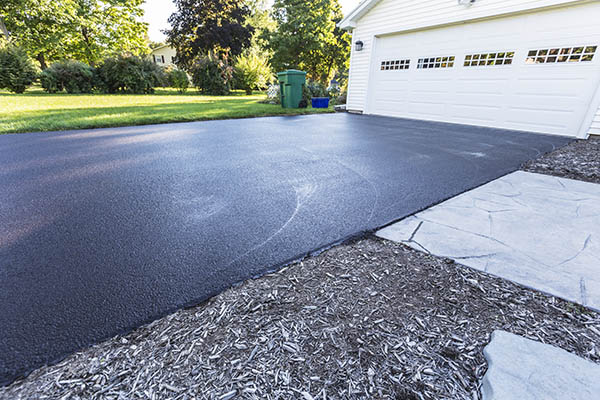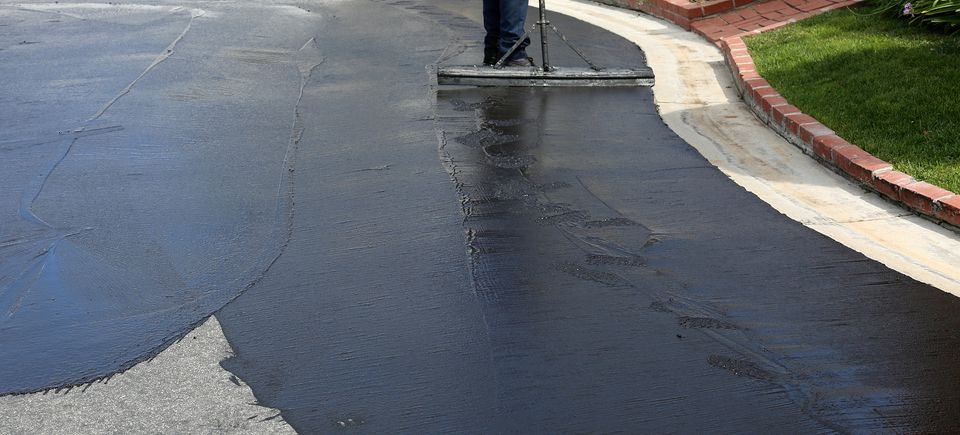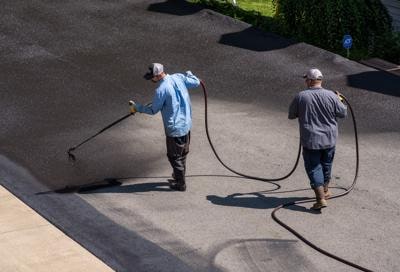Open the Keys of Asphalt Sealing: Making Best Use Of Warm Mix Asphalt Long Life
Open the Keys of Asphalt Sealing: Making Best Use Of Warm Mix Asphalt Long Life
Blog Article
Hot Mix Asphalt: A Lasting Solution for Sidewalk
Hot Mix Asphalt (HMA) has actually arised as a leading sustainable choice for pavement remedies, providing a myriad of ingenious technologies and environmental advantages. As the demand for eco-friendly building methods grows, discovering the nuances of HMA's sustainability can supply important understandings right into the future of pavement remedies.
Environmental Benefits of Warm Mix Asphalt

Moreover, Hot Mix Asphalt assists to alleviate city heat island effects. Its dark shade takes in sunlight, decreasing the amount of warm reflected back into the atmosphere compared to lighter-colored sidewalks. This can lower ambient temperatures in urban locations, decreasing the demand for a/c and inevitably minimizing energy consumption.
Additionally, Warm Mix Asphalt adds to enhanced stormwater management. Its porous nature allows water to recharge and penetrate the pavement groundwater supplies, decreasing runoff and the risk of flooding. These environmental advantages make Warm Mix Asphalt a sustainable choice for leading highways and roadways.
Power Efficiency in HMA Manufacturing
Is energy performance a crucial aspect in the manufacturing of Warm Mix Asphalt (HMA)? Energy plays a significant function in the manufacturing of HMA, influencing both cost and ecological sustainability. One vital element of energy effectiveness in HMA manufacturing is the usage of warm mix asphalt (WMA) technologies.
In addition, advancements in plant modern technologies have led to even more energy-efficient HMA manufacturing processes. By enhancing energy use in HMA production, the market can lower its carbon footprint while preserving high-quality sidewalk products.
Recyclability of Hot Mix Asphalt
The recyclability of Hot Mix Asphalt (HMA) is an essential aspect of its sustainability and lasting environmental effect. HMA is just one of the most recycled materials in the United States, with over 100 million lots of recovered asphalt sidewalk (RAP) being recycled annually in new sidewalk building and construction. Reusing HMA supplies several environmental benefits, such as lowering the need for virgin materials, reducing power intake throughout production, and reducing the quantity of waste sent to garbage dumps.
The procedure of reusing HMA entails milling the existing pavement, crushing it right into smaller sized items, and mixing it with new aggregate and asphalt binder to produce a recycled mix. This recycled mix can commonly execute along with or even far better than standard HMA, while calling for fewer resources and generating lower greenhouse gas discharges. By integrating RAP right into new pavement jobs, road companies can save all-natural resources, minimize costs, and lessen the environmental impact of roadway construction and upkeep tasks. Overall, the recyclability of HMA plays a substantial function in promoting lasting methods within the sidewalk industry.

Long-Term Performance of HMA
Asphalt sidewalks show longevity and strength over an extended duration, reflecting the long-lasting performance of Warm Mix Asphalt (HMA) The longevity of HMA can be associated to its capacity to stand up to rush hour lots, harsh climate condition, and the impacts of aging. Research studies have actually revealed that properly designed and appropriately built HMA sidewalks can last for twenty years or more with normal upkeep. The key to making the most of the long-lasting performance of HMA lies in utilizing high-quality products, following ideal methods in building, and implementing reliable upkeep approaches. Appropriate water drainage, routine assessments, and prompt repairs are important for preserving the structural honesty of HMA sidewalks with time. In addition, innovations in HMA innovation, such as making use of polymer-modified binders and warm mix asphalt, have actually better improved the longevity and long life of HMA sidewalks. By prioritizing quality building and maintenance techniques, HMA remains to verify itself as a lasting and cost-effective remedy for durable pavement facilities.

HMA: Resilience and Sustainability
Demonstrating both toughness and sustainability, Hot Mix Asphalt (HMA) has actually come to be a foundation in the construction linked here of resilient pavement infrastructures - angled parking. HMA's longevity stems from its capability to hold up against heavy tons, severe climate conditions, and high traffic volumes, making it a trustworthy option for roads, highways, and airport terminal runways. The make-up of HMA, which normally includes aggregates, binder, and filler, plays an important duty in enhancing its longevity and resistance to deterioration
Additionally, HMA's sustainability lies in its recyclability and energy-efficient manufacturing process. The ability to recycle redeemed asphalt pavement (RAP) in new HMA combinations lowers the demand for virgin materials and decreases the environmental effect of sidewalk building and construction and upkeep. Additionally, the energy performance of producing HMA depends on its lower blending temperatures contrasted to various other pavement materials, leading to minimized energy usage and greenhouse gas exhausts.
Verdict
To conclude, hot mix asphalt (HMA) offers a sustainable remedy for sidewalk with its eco-friendly characteristics. HMA's recyclability, power performance in production, and long-term toughness make it an environmentally friendly selection for road building. By preserving natural deposits, decreasing waste, and reducing greenhouse gas discharges, HMA plays a crucial duty in advertising sustainability in framework advancement. Its capacity to mitigate city warmth island impacts further emphasizes its value in producing resistant and environmentally mindful sidewalk systems.
HMA is one of the most recycled products in the United States, with over 100 million tons of reclaimed asphalt pavement (RAP) being reused every year in brand-new pavement building and construction.The procedure of recycling HMA includes crushing the existing pavement, squashing it into smaller sized pieces, and mixing it with brand-new aggregate and asphalt binder to create a recycled mix.Asphalt sidewalks demonstrate longevity and durability over a prolonged period, mirroring the long-term efficiency of Hot Mix Asphalt (HMA) Additionally, innovations in HMA browse around this site modern technology, such as the use of polymer-modified binders and warm mix asphalt, have better improved the durability and longevity of HMA pavements. The capability to recycle recovered asphalt pavement (RAP) in new HMA mixtures minimizes the demand for my blog virgin products and minimizes the ecological influence of pavement building and maintenance.
Report this page